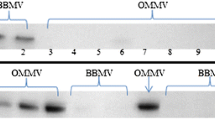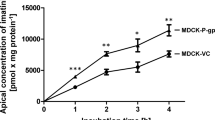Abstract
In order to test what chemical structure is required for a substrate to interact not only with the contraluminal organic anion (p-aminohippurate, PAH) transporter, but also with the organic cation (N 1-methylnicotinamide, NMeN, or tetraethylammonium, TEA) transporter, the stop-flow peritubular capillary perfusion method was applied and app. K i values were evaluated. Zwitterionic hydrophobic dipeptides not only interact with PAH but also with NMeN transport although with lower inhibitory potency (K i,PAH=0.2–1.4; K i,NMeN 614 mmol/l). Amongst the zwitterionic cephalosporins, which all inhibit PAH transport, the amino cephalosporin analogue cefadroxil was identified to interact also with NMeN transport (K i,PAH = 3.0, K i,NMeN=11.2 mmol/l). All Zwitterionic naphthyridine and oxochinoline gyrase inhibitors tested inhibit NMeN transport with app. K i,NMeN values between 1.2 mmol/l and 4.7 mmol/l; the naphthyridine analogues show a good inhibitory potency against PAH transport (K i,PAH ≈ 0.4 mmol/l), the piperazine-containing quinolone analogues have a moderate inhibitory potency (K i,PAH=1.1–2.5 mmol/l) and the piperazine-containing pipemidic acid did not inhibit PAH transport at all. Zwitterionic thiazolidine carboxylate phosphamides also interact with both transporters (app. K i,PAH ≈ 3.0; app. K i,NMeN ≈ 18.0 mmol/l). The nonionizable oxo- and hydroxy-group-containing corticosteroid hormones also interact with the two transporters. (a) An OH group in position 21 is necessary for interaction with the PAH transporter, but not for interaction with the TEA transporter. (b) Introduction of an OH group in position 17α abolishes interaction with the TEA transporter, but has different effects with the PAH transporter. (c) Introduction of an OH group in position 6 abolishes interaction with both, the PAH and the TEA transporter. (d) A change of the side-group in position 11 of corticosterone from -OH to -H to=O enhances interaction with the PAH transporter but has no effect on the interaction with the TEA transporter. Nonionizable 4- or 5-androstene analogues inhibit both transporters with app. K i between 0.16 mmol/l and 0.64 mmol/l, if the steroids are soluble in a concentration greater than 1 mmol/l. Nonionizable oxazaphosphorins with more than one chloroethyl group interact with the PAH transporter with app. K i between 0.84mmol/l and 4.9mmol/l and with the NMeN transporter with app. K i between 3.2 mmol/l and 18.7 mmol/l. Thus a substrate interacts with both transporters if it is sufficiently hydrophobic, possesses acidic and/or electron-attracting plus basic and/or electron-donating groups, or possesses several electron-attracting nonionizable groups (O, OH, Cl). A certain spatial arrangement of the interacting groups seems to be necessary.
Similar content being viewed by others
References
Babin-Ebell J, Russ H, Gliese M, Schömig E (1991) Inhibition of the renal transport system for organic cations by steroids. Naunyn-Schmiedeberg's Arch Pharmacol 343: R 92
Child KJ, Dodds MG (1967) Nephron transport and renal tubular effects of cephaloridine in animals. Br J Pharmacol Chemother 30: 354–370
Fritzsch G, Haase W, Rumrich G, Fasold H, Ullrich KJ (1984) A stopped flow capillary perfusion method to evaluate contraluminal transport parameters of methylsuccinate from interstitium into renal proximal tubular cells. Pflügers Arch 400: 250–256
Fritzsch G, Rumrich G, Ullrich KJ (1989) Anion transport through the contraluminal cell membrane of renal proximal tubule. The influence of hydrophobicity and molecular charge distribution on the inhibitory activity of organic anions. Biochim Biophys Acta 978: 249–256
Harrison NL, Majewska MD, Harrington JW, Barker JL (1987) Structure-activity relationships for steroid interaction with the gamma-aminobutyric acidA receptor complex. J Pharmacol Exp Ther 241: 346–353
Herzfeldt CD (1980) Dissoziationskonstanten von Arzneistoffen: Eine Übersichtstabelle. Pharm Ztg 125: 608–614
Inui KI, Okano T, Takano M, Saito H, Hori R (1984) Carriermediated transport of cephalexin via the dipeptide transport system in rat renal brush border membrane vesicles. Biochim Biophys Acta 769: 449–454
Inui KI, Takano M, Okano T, Hori R (1985) H+-gradientdependent transport of aminocephalosporins in rat renal brush border membrane vesicles: role of H+/organic cation antiport system. J Pharmacol Exp Ther 233: 181–185
Kamiya A, Okumura K, Hori R (1983) Quantitative investigation of renal handling of drugs in rabbits, dogs and humans. J Pharm Sci 72: 440–443
Kasher JS, Holohan PD, Ross CR (1983) Effect of cephaloridine on the transport of organic ions in dog kidney plasma membrane vesicles. J Pharmacol Exp Ther 225: 606–610
Kleyman TR, Cragoe EJ Jr (1988) Amiloride and its analogs as tools in the study of ion transport. J Membr Biol 105: 1–21
Kramer W, Leipe I, Petzold E, Girbig F (1988) Characterization of the transport system for β-lactam antibiotics and dipeptides in rat renal brush border membrane vesicles by photoaffinity labeling. Biochim Biophys Acta 939: 167–172
Majewska MD, Harrison NL, Schwartz RD, Barker JL, Paul SM (1986) Steroid hormone metabolites are barbiturate-like modulators of the GABA receptor. Science 232: 1004–1007
Nixon RL, Janowsky DS, Davis JM (1974) Effects of progesterone, β-estradiol, and testosterone on the uptake and metabolism of 3H-norepinephrine, 3H-dopamine and 3H-serotonin in rat brain synaptosomes. Res Commun Chem Pathol Pharmacol 7: 233–236
Paul SM, Purdy RH (1992) Neuroactive steroids. FASEB J 6: 2311–2322
Raymond GG, Born JL (1986) An updated pK a listing of medicinal compounds. Drug Intell Clin Pharm 20: 683–686
Sanchez-Bueno A, Sancho MJ, Cobbold PH (1991) Progesterone and oestradiol increase cytosolic Ca2+ in single rat hepatocytes. Biochem J 280: 273–276
Schömig E, Schönfeld CL (1990) Extraneuronal noradrenaline transport (uptake2) in a human cell line (caki-1 cells). Naunyn-Schmiedeberg's Arch Pharmacol 341: 404–410
Sörgel F, Kinzig M (1993) Pharmacokinetics of gyrase inhibitors, part 1: Basic chemistry and gastrointestinal disposition. Am J Med 94 (suppl 3A) 44S-55S
Steidl M, Pinggera G, Ritter M, Lang F (1991) Progesterone inhibits K conductance in plasma membrane of cultured renal epitheloid MDCK cells. Am J Physiol 260: E743-E750
Thorn NA, Nielsen FS, Jeppesen CK (1991) Characteristics of ascorbic acid uptake by isolated ox neurohypophyseal nerve terminals and the influence of glucocorticoid and tri-iodothyronine on uptake. Acta Physiol Scand 141: 97–106
Tune BM, Fernholt M, Schwartz A (1974) Mechanism of cephaloridine transport in the kidney. J Pharmacol Exp Ther 191: 311–317
Twyman RE, Macdonald RL (1992) Neurosteroid regulation of GABAA receptor single-channel kinetic properties of mouse spinal cord neurons in culture. J Physiol (Lond) 456: 215–245
Ueda K, Okamura N, Hirai M, Tanigawara Y, Saeki T, Kioka N, Komano T, Hori R (1992) Human P-glycoprotein transports cortisol, aldosterone, and dexamethasone, but not progesterone. J Biol Chem 267: 24 248–24 252
Ullrich KJ, Rumrich G (1990) Kidney: microperfusion — double-perfused tubule in situ. Methods Enzymol 191: 98–107
Ullrich KJ, Rumrich G (1992) Renal contraluminal transport systems for organic anions (paraaminohippurate, PAH) and organic cations (N 1-methyl-nicotinamide, NMeN) do not see the degree of substrate ionization. Pflügers Arch 421: 286–288
Ullrich KJ, Rumrich G, Schrinner E (1986) Cephalosporin (cefodizim) transport in the rat proximal renal tubule. Kidney Int 29: 1256
Ullrich KJ, Rumrich G, Klöss S (1988) Contraluminal paraaminohippurate (PAH) transport in the proximal tubule of the rat kidney. IV. Specifity: mono- and polysubstituted benzene analogs. Pflügers Arch 413: 134–146
Ullrich KJ, Rumrich G, Klöss S (1989) Contraluminal organic anion and cation transport in the proximal renal tubule. V. Interaction with sulfamoyl- and phenoxy diuretics, and with β-lactam antibiotics. Kidney Int 36: 78–88
Ullrich KJ, Rumrich G, Wieland T, Dekant W (1989) Contraluminal para-aminohippurate (PAH) transport in the proximal tubule of the rat kidney. VI. Specificity: amino acids, their N- methyl-, N-acetyl- and N-benzoylderivates; glutathione- and cysteine conjugates, di- and oligopeptides. Pflügers Arch 415: 342–350
Ullrich KJ, Papavassiliou F, David C, Rumrich G, Fritzsch G (1991) Contraluminal transport of organic cations in the proximal tubule of the rat kidney. I. Kinetics of N1-methylnicotinamide and tetraethylammonium, influence of K+, HCO3 −; pH, inhibition by aliphatic primary, secondary and tertiary amines, and mono- and bisquarternary compounds. Pflügers Arch 419: 84–92
Ullrich KJ, Rumrich G, Papavassiliou F, Hierholzer K (1991) Contraluminal p-aminohippurate transport in the proximal tubule of the rat kidney. VIII. Transport of corticosteroids. Pflügers Arch 418: 371–382
Ullrich KJ, Rumrich G, Fritzsch G (1992) Substrate specifity of the organic anion and organic cation transport systems in the proximal renal tubule. In: Bamberg E, Passow H (eds) Progress in Cell Research, vol 2. Elsevier, Amsterdam, pp 315–321
Ullrich KJ, Rumrich G, Neiteler K, Fritzsch G (1992) Contraluminal transport of organic cations in the proximal tubule of the rat kidney. II. Specifity: anilines, phenylalkylamines (catecholamines), heterocyclic compounds (pyridines, quinolines, acridines). Pflügers Arch 420: 29–38
Ullrich KJ, Rumrich G, David C, Fritzsch G (1993) Bisubstrates: substances that interact with renal contraluminal organic anion and organic cation transport systems. I. Amines, piperidines, piperazines, azepines, pyridines, quinolines, imidazoles, thiazoles, guanidines and hydrazines. Pflügers Arch 425: 280–299
Wehling M, Christ M, Theisen K (1992) Membrane receptors for aldosterone: a novel pathway for mineralcorticoid action. Am J Physiol 263: E 974-E 979
Wehling M, Käsmayr J, Theisen K (1991) Rapid effects of mineralocorticoids on sodium-proton exchanger: genomic or nongenomic pathway. Am J Physiol 260: E 719-E 726
Author information
Authors and Affiliations
Rights and permissions
About this article
Cite this article
Ullrich, K.J., Rumrich, G., David, C. et al. Bisubstrates: substances that interact with both, renal contraluminal organic anion and organic cation transport systems. Pflügers Arch 425, 300–312 (1993). https://doi.org/10.1007/BF00374180
Received:
Revised:
Accepted:
Issue Date:
DOI: https://doi.org/10.1007/BF00374180




